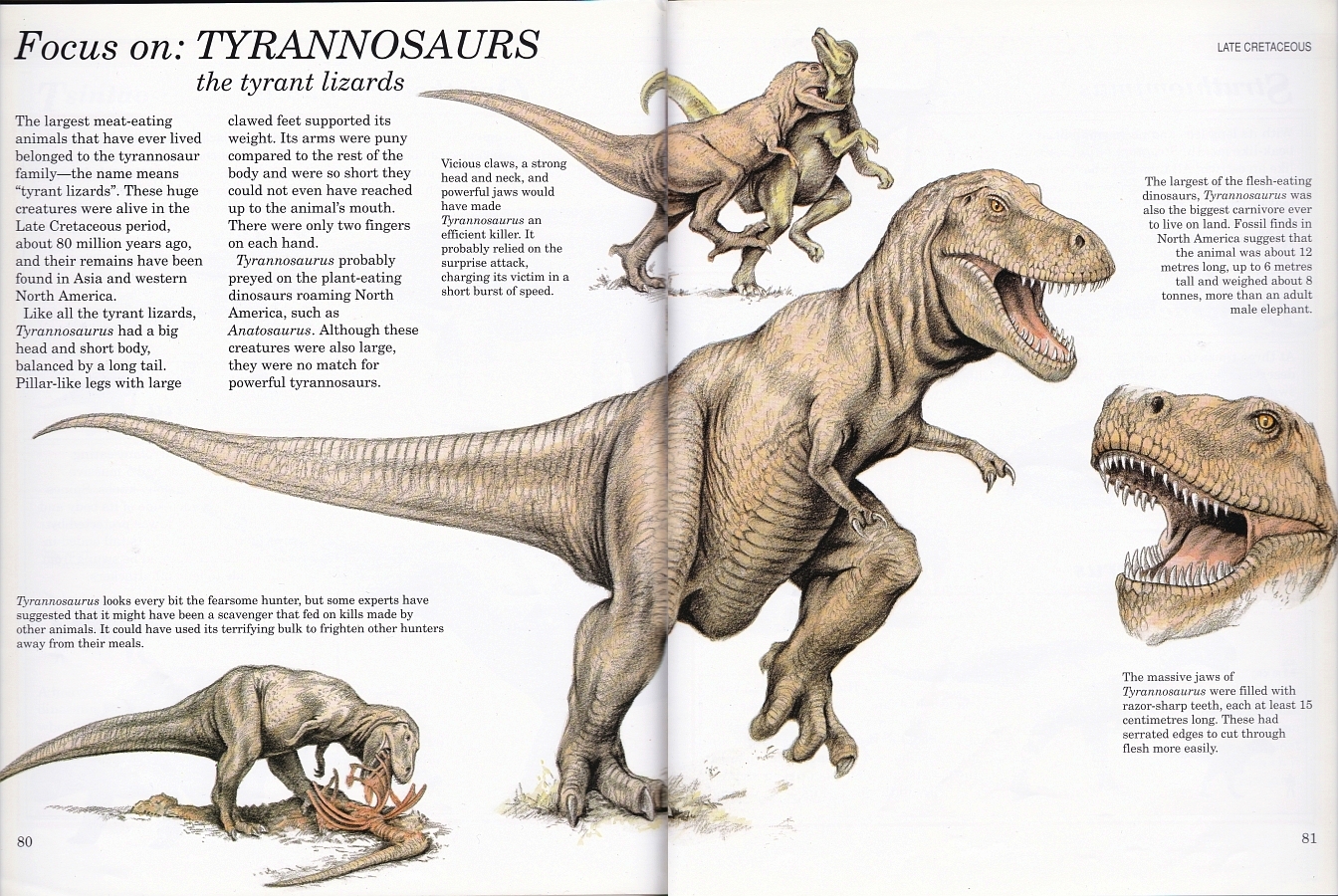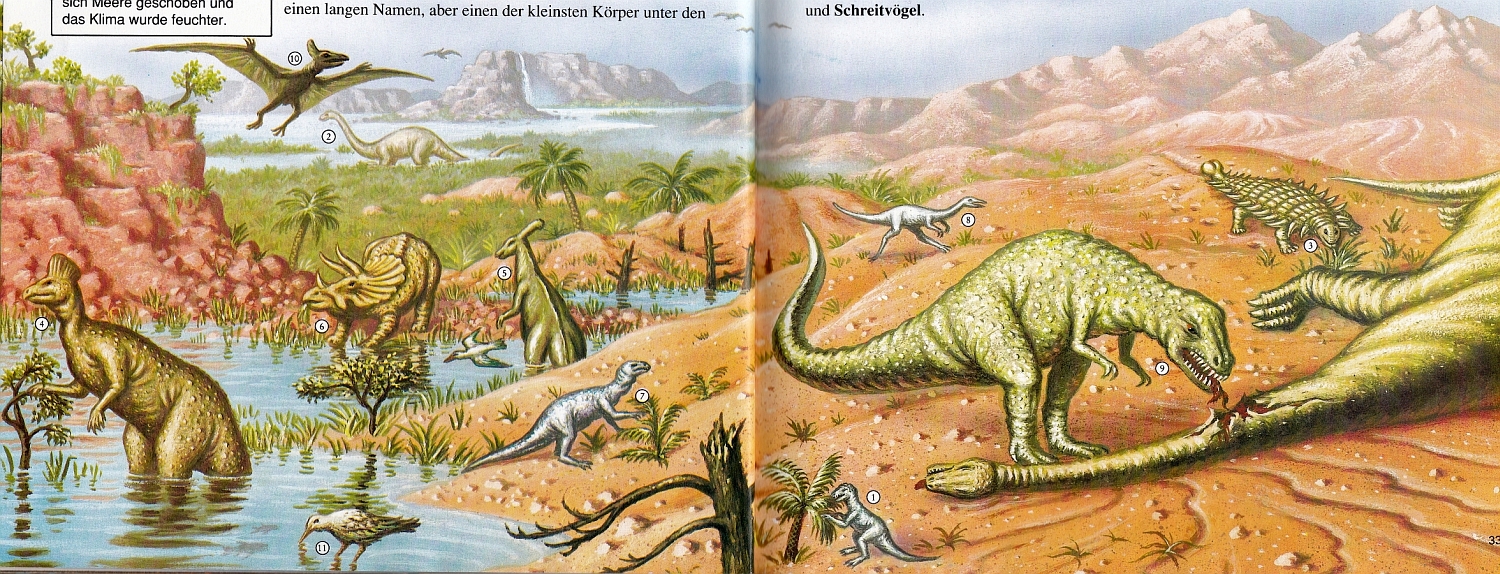Who doesn’t love a bit of Steve Kirk? I’ve featured his work numerous times on LITC over the years – both here and over on version 1.0 – and I simply can’t get enough. Imagine my delight, then, when I found hitherto unseen Kirkwork in a book for sale in an Oxfam bookshop on Blatchington Road, Hove, just a short walk from where I live. And priced at just 49 pence! Not even this book’s clear designation as being For Children could deter me.

The Gollancz Dinosaur Encylopaedia for Children – confusingly “conceived, edited and designed by Marshall Editions” but published by Victor Gollancz, “an imprint of Cassell” (which itself has a convoluted history) – is mostly a rather straightforward ‘spotters guide’-type book, with isolated illustrations of animals featuring alongside a short bit of text describing them. First published in 1992 (with this edition arriving in 1993), it features a huge number of rather bland-looking brown, green and grey reconstructions of prehistoric animals (not just dinosaurs), which I never would have attributed to Steve Kirk were it not for a credit in the back. Kirk’s name, for me, evokes memories of brightly-coloured dinosaurs, running around in vibrant landscapes and illustrated from intriguing, jaunty perspectives – not the competent, but very dull reconstructions that pepper this book. Happily, we are treated to some classic Kirk here too.

A series of panorama images break up the dino-catalogue, and they’re far, far more exciting than anything else on offer here. The above scene, depicting Coelophysis, Massospondylus, Metoposaurus (the temnospondyl) and Trilophosaurus (the, er, non-dinosaur reptile) is typical. Freed from the confines of the encyclopedia format, Kirk’s stunningly stripy theropods stalk, hunt, and lunge towards the viewer. As ever, my scanner is too small to take in the whole thing, so I’ve been forced to stitch the two pages together, with the black line indicating where things have been lost in the fold. Still, it’s possible to appreciate Kirk’s canny use of perspective; we’re given an almost human’s-eye-view of the scene, which really helps us feel part of the dried-up Triassic landscape. Kirk has also seemingly placed a tiny reflection of a moustachioed man in the Coelophysis‘ pupil – which is probably a reflection of himself. Not too surprising – after all, if his viewpoint was that close, he might well glimpse himself…
As an aside: Massospondylus didn’t quite live in the Late Triassic, but was probably deemed ‘close enough’. This is a bit of a recurring theme, as we shall see.

I’d be tempted to say that the Late Triassic scene was my favourite, but the very busy Early Jurassic panorama certainly gives it a run for its money. It’s particularly superb in effectively highlighting specific species, but still conveying a complete ecosystem with a wide variety of fauna. It features multiple ichthyosaurs, with Ichthyosaurus (on the left), Temnodontosaurus (on the right), and Eurhinosaurus (at the bottom) all getting in on the action. What’s more, the fish aren’t just generic stand-ins, but positively identified as Lepidotes (top left), Pholidophorus (top right) and Dapedium (bottom right). I’m aware that Lepidotes is a wastebasket taxon, although I’m not sure about the others.The invertebrates aren’t identified, but then, who cares for them? Bloody Jurassic invertebrates. Can’t walk down the beach at Lyme Regis without tripping over them.
In any case – this is beautifully done. Kirk certainly paints dappled light in a very pleasing manner. And there’s more!

The Late Jurassic scene showcases what, at first glance, appears to be some Morrison Formation fauna – but these are actually European animals. Given how typical it was for artists of the time to stick large Late Jurassic dinosaurs in a largely empty, arid setting with a few cycads and tree ferns scattered around to liven things up, it’s commendable that Kirk very much makes his dinosaurs feel as if they are just one part of a complete palaeoenvironment. When I did a little livesteam over on the Facebooks about this book, Joschua Knüppe suggested that perhaps Kirk had been taking notes from Doug Henderson. Could be – that fallen tree in particular is very Hendersonian – but this certainly isn’t a Henderson copy, and if you’re going to be inspired by anyone, Henderson is an excellent bet. I always appreciate it when artists depict sauropods (in this case, Cetiosaurus) as dwarfed by colossal trees, something that both Henderson and Kirk have done on a number of occasions. I also really like the image of Megalosaurus lurking in the shadows, stalking its prey through the forest. (Yes – that’s Megalosaurus without any hunchback weirdness going on. Hooray!)
The oddity here is that Middle Jurassic animals – Cetiosaurus and Megalosaurus – have been thrown into what’s ostensibly a Late Jurassic scene with plenty of genuine Late Jurassic inhabitants, namely Archaeopteryx, Scaphognathus and “Camptosaurus” (presumably the animal now known as Cumnoria). It’s probable that the Middle Jurassic pair are just stand-ins for similar Late Jurassic counterparts. Or, they’re just too famous not to include. Whatever.

For the Early Cretaceous panorama, Kirk opts for a quite different perspective – rather than being placed almost at human eye-height (OK, perhaps scuba diving on one occasion), we’re now taken above the treetops, with the scene dominated by the pterosaur Dsungaripterus. Again, the vibrant and interesting, yet plausible colouration of the animals here is quite lovely (with the possible exception of the boring grey Euhelopus) – I’m especially fond of the pterosaurs’ colourful faces, which contrast with their more camouflaged bodies. Of all the panoramas, this might be the most naturalistic, with animals depicted eating, interacting, wading, and simply lounging around as large herbivores are wont to do.
Aside from Dsungaripterus and Euhelopus, this scene also features the stegosaur Wuerhosaurus and the iguanodont Altirhinus, here identified as “Iguanodon mongolensis“. I’d never heard that specific name before, so promptly went to check Wikipedia, which lists it as a nomen nudum under “reassigned species of Iguanodon” and cites…this book. Again, not all of these animals necessarily lived at exactly the same time, but…nyeh. Somehow (for entirely irrational reasons, I’m sure) it’s less egregious to me than sticking Tyrannosaurus and Corythosaurus in the same image…

…Which is exactly what happens in the Late Cretaceous panorama! Got to love how moody this scene is, though, with a swirling vortex of storm clouds and a highly dramatic flash of forked lightning signalling the arrival of Dracul…the tyrant king. More gloriously funky patterns on the hadrosaurs, and I love the idea of taking a worm’s eye view as T. rex storms in, even if Rexy himself has some issues. Aside from being boringly brown, there are some possible perspective fudges going on at the head end, with the orientation of the head relative to the neck in particular looking odd (if somewhat typical for the late ’80s). Still, it’s rather good for the time, and those feet (complete with pads) look great. Mmm, theropod feet.

While this book is dominated by the Work of the Kirk, a handful of spreads illustrated by another artist – Mark Iley – also feature. These are rather different in style, and mostly focus on a single animal, such as Stegosaurus (above). There’s something rather retro about the way the plates and spikes erupt from the animal’s skin that pleases me, somehow. We’re also treated to a range of possible plate configurations (all featuring a very pre-Renaissance-looking Steggy with a low, walnut-brained stance) and the most fantastically awkward-looking Allosaurus I’ve seen in quite some time. It looks rather like it should have eyeholes in its neck.

Even better is this spread on Tyrannosaurus. Yes, Tyrannosaurus gets to dominate two spreads, but then, that’s only the correct order of things. The rich man in his castle, the poor man at his gate, and Rexy sprawling all over your dinosaur books like the fat, ugly, bastard murderchicken he surely is. The main illustration here is clearly based on a model that’s been on display in the Natural History Museum (London) for some decades – at least from the neck up. Why, it even retains the ear placed incorrectly in the temporal fenestra. While the NHM model isn’t actually a tail dragger, it’s rather old-school nonetheless, which perhaps explains why Iley has given the body a makeover here. While the scutes are gone and the pose is much more dynamic, that torso doesn’t half look odd – like half of the animal’s ribcage is missing. Rexy’s also given a reversed hallux here, in true retro style, and it’s quite large, too. I imagine it’s to support the animal’s considerable tonnage, rather than to perch on logs or prise off bottle caps. Wonderful stuff.
And that’s all, unless anyone’s dead keen on seeing some of those grey-green-brown Kirk catalogue illustrations – in which case, let me know!







6 Comments
Sophie
September 10, 2020 at 9:31 pmI’d love to see some of the other illustrations. This was my very first “big kid” dinosaur book (it was a Christmas gift when I was four) and I carried it with me everywhere. I still have the tattered remains of my original copy plus a replacement copy in nearly new condition. Interestingly enough, this book was updated at least three or four times during the early 2000’s and much of the art was updated or replaced. The panoramas were usually replaced with ones by the recently departed James Fields. I’d be happy to send a few scans some time if anyone would want to see!
wyx
September 11, 2020 at 4:44 pmEveryone I knew in my preteen years who was into dinosaurs seemed to have this one, it was like *the* essential entry-level book on dinosaurs. One of my classmates even had a rough imitation of the Late Jurassic scene painted on his bedroom wall. Kirk’s art was just as influential to me; sometimes when I hear or read the name of a prehistoric animal, my mind goes straight to this book and its page layout. Nice that he’s been getting some well deserved recognition in recent times. Thanks to my personal history with this book (and others that have either reprinted or copied its images), I always considered his art to be up there with the works of any big-name paleoartist, it’s just a shame that for the longest time I didn’t even know his name.
My copy didn’t quite survive the ’90s though, only a few torn up pages and the binding are left. It has a high spot on my “old books I should re-buy” list.
Marc Vincent
September 11, 2020 at 4:51 pmIt’s peculiar that I’ve only really noticed Kirk’s 1990s work in my adulthood, given that I was the ideal age at the time (and very into dinosaurs). I’m happy to hear that there are others out there who appreciate it.
marekdzurenko
September 14, 2020 at 6:10 amYep, this was one of those essential dino books I grew up with as a kid. Any chance for a second part focusing on the illustrations of single animals?
Gray Stanback
September 24, 2020 at 10:36 amSomehow (for entirely irrational reasons, I’m sure) it’s less egregious to me than sticking Tyrannosaurus and Corythosaurus in the same image…
If you want, you can ignore what the book says and pretend they’re actually Hypacrosaurus instead.
paleocharley
November 10, 2021 at 12:15 pmWhat, a Triassic scene near water WITHOUT phytosaurs! Sacrilege!!! WHERE ARE MY PHYTOSAURS!